Background of RUNE Protocol
Summarize the biggest feature of the "Runes" protocol in one sentence: A simple, UTXO-based protocol for homogeneous tokens that enables Bitcoin users to have a good user experience.
The design of Runes focuses on usability and is expected to bring important changes to the Bitcoin token ecosystem. By adopting Bitcoin's UTXO model, Runes provides a "harm reduction" solution by reducing unnecessary inflation of the UTXO set, addressing a significant issue faced by existing protocols such as BRC-20 and Stamps. Its simplified design is expected to attract more developers' interest and participation, potentially driving innovation in the Bitcoin development community. The seamless user experience is also expected to attract more mainstream users, as they do not need to deal with native tokens or the complexity off-chain. Overall, Runes provides a simpler and more intuitive way to handle replaceable tokens on the Bitcoin blockchain.
Timeline of Key Events
- December 14, 2022: Casey releases the Ordinals protocol, allowing data to be inscribed on the smallest unit of Bitcoin (satoshi), enabling users to write text, images, audio, video, etc. on satoshis.
- March 8, 2023: Domo, an anonymous developer, releases the BRC20 protocol based on the Ordinals protocol and mints the first token asset ORDI, with a current market value of 1.4 billion USD.
- May 8, 2023: Bitcoin core developers publish an article claiming that "BRC20 protocol has caused too much spam and frequent transactions, leading to network congestion in the BTC community, and action should be taken to stop it."
- September 1, 2023: Casey publicly opposes the BRC20 protocol and hopes to stop minting BRC-20.
- September 28, 2023: Casey writes a blog proposing the Rune protocol based on the UTXO model and claims "this may be a bad idea."
- September 28, 2023: The ordi community begins developing the RUNE protocol and announces plans to launch the mainnet in April, at the next Bitcoin halving.
- November 14, 2023: RuneAlpha is established and takes an early step to release the RUNE protocol, concurrently developing the fair mint RUNE protocol token tool and publicly minting $COOK, with a market value of 27 million USD at the time of this article's publication.
- January 15, 2024: RuneAlpha announces its commitment to building the infrastructure of the Rune protocol and publishes specific implementation plans.
- January 29, 2024: OKX publicly announces support for RuneAlpha on its wallet by the end of February and holds an AMA meeting with RuneAlpha founder @sondotpin.
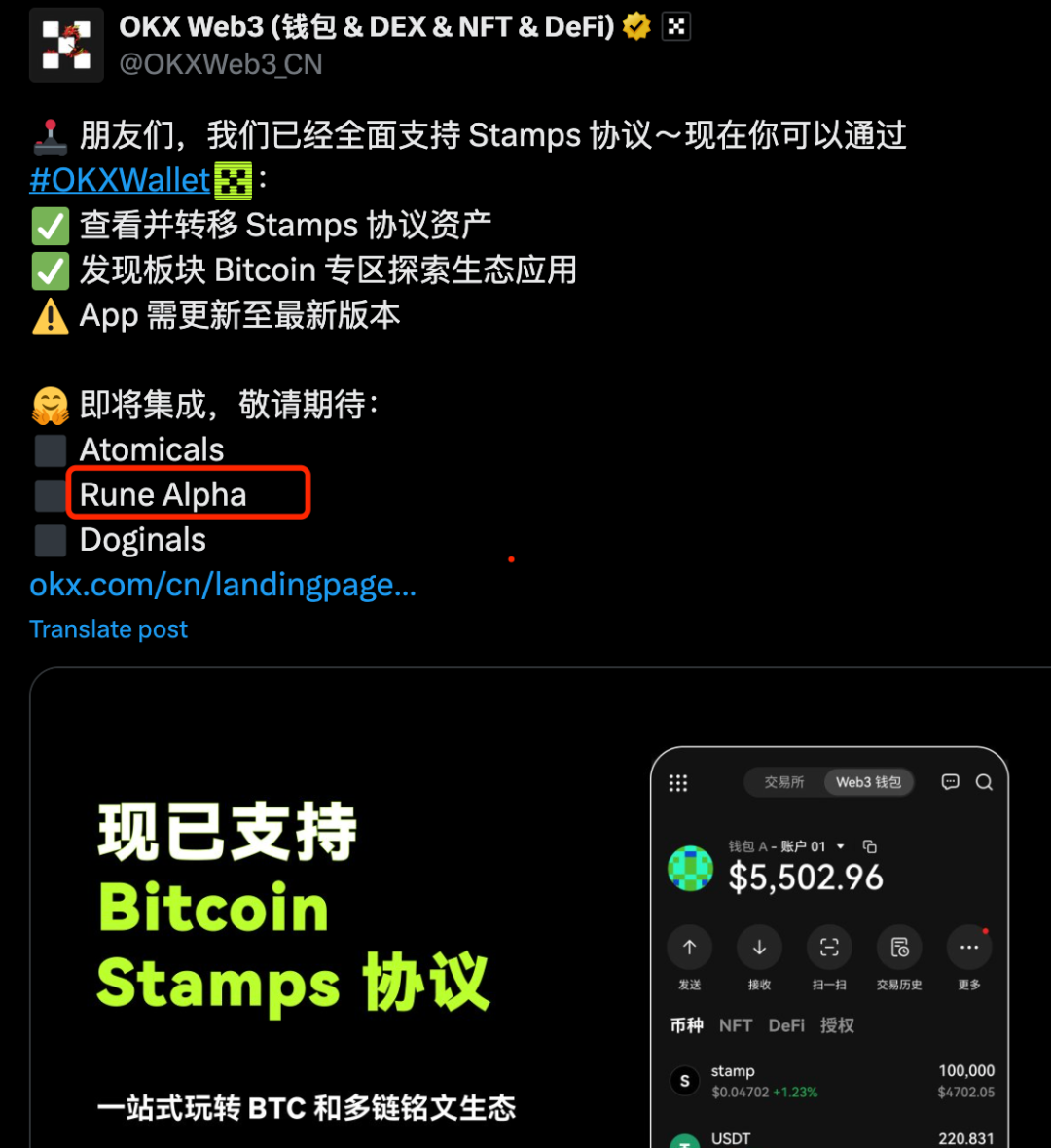
- January 20, 2024: The RUNECOIN project is established and announces the distribution of RSIC inscriptions through airdrops, and will exchange them for RUNE protocol mainnet tokens at the corresponding ratio after the mainnet goes live.
- February 12, 2024: Casey publicly announces the release of 10 initial runes in hardcoded form when the mainnet goes live.
- February 17, 2024: The Chinese community is officially established and attracts numerous Twitter influencers to participate in discussions and construction.
Detailed Explanation of Important Events
I. What are Inscriptions
Bitcoin Inscriptions are metadata inscribed on satoshis using Ordinals, also known as "Bitcoin NFTs."
If Bitcoin is likened to digital gold, then inscriptions are the jewelry made of gold. They share the same essence. Inscriptions refer to the process of embedding arbitrary data into the Bitcoin blockchain through transaction witness data.
II. What is BRC20
BRC-20 is a set of inscriptions based on the Ordinals protocol. It specifies the token name, total token supply, and the quantity of tokens minted per inscription in a certain data format. In the example below, "Panda" is the token name, with a maximum token quantity of 100 million, and a maximum token quantity minted per inscription of 10,000. BRC-20 currently exists as a form between tokens and NFTs, or possesses characteristics of both, making it very interesting.
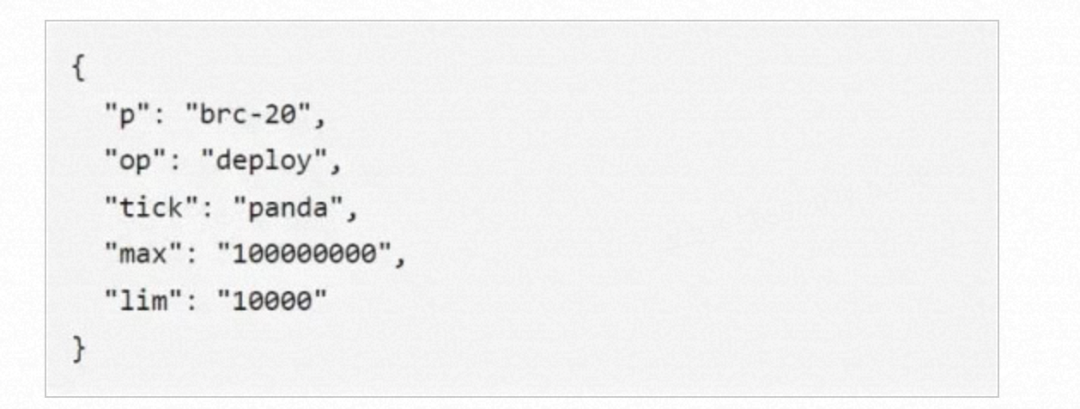
BRC-20 is actually a token issuance standard on Bitcoin, specifying the name, issuance quantity, transfer, and other functions of tokens issued on Bitcoin. It was created by community enthusiast @domodata on March 8, 2023. More than 30,000 "inscriptions" were minted on the second day of its creation, with nearly 27,000 of them being of the text type. The creator of BRC-20 emphasized that this was just an experiment aimed at testing whether token minting and transfer could be done through the Bitcoin NFT Ordinals protocol and whether it could promote the "replaceability" of Bitcoin. The first BRC-20 token deployed was ordi, with a limit of 1,000 mintings each time and a total supply of 21 million. Since its issuance, ordi has increased by over 100 times.
III. Issues Caused by BRC20
On May 8, 2023, BTC core developer Luke Dashjr discussed in the BTC community, claiming that "BRC20 protocol has caused too much spam and frequent transactions, leading to network congestion in the BTC community, and action should be taken to stop it."
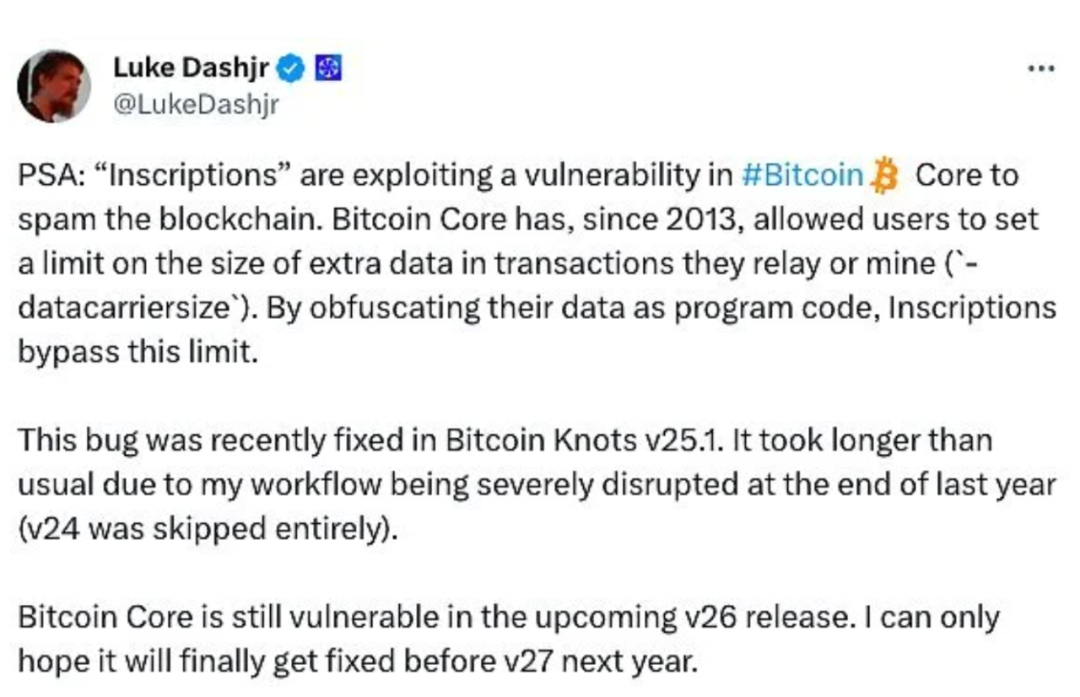
BRC-20 allows the minting and transfer of replaceable tokens on Bitcoin through the Ordinals protocol. Casey Rodarmor, the founder of the Ordinals protocol, believes that the problem with BRC-20 tokens is that they send "junk" unused transaction outputs (UTXOs) to Bitcoin. Additionally, because the BRC-20 protocol is based on the Ordinals protocol, it essentially adds an unnecessary layer of protocol.
Casey Rodarmor explained in an article on September 26 that BRC-20 tokens have "adverse consequences of UTXO diffusion" and suggested using Runes as an alternative based on UTXO.
IV. Background of the Birth of RUNES Protocol
In the official manual of the Ordinals protocol, we can see that Casey's vision for the Ordinals protocol was to create "digital artifacts" or "NFTs" through Bitcoin. However, as the Ordinals protocol developed, the number of inscriptions related to BRC-20 has accounted for over 85% of the total inscriptions.
Casey has been dissatisfied with BRC-20 for a long time, especially with his recent controversial tweets, which further demonstrate his negative attitude towards BRC-20.
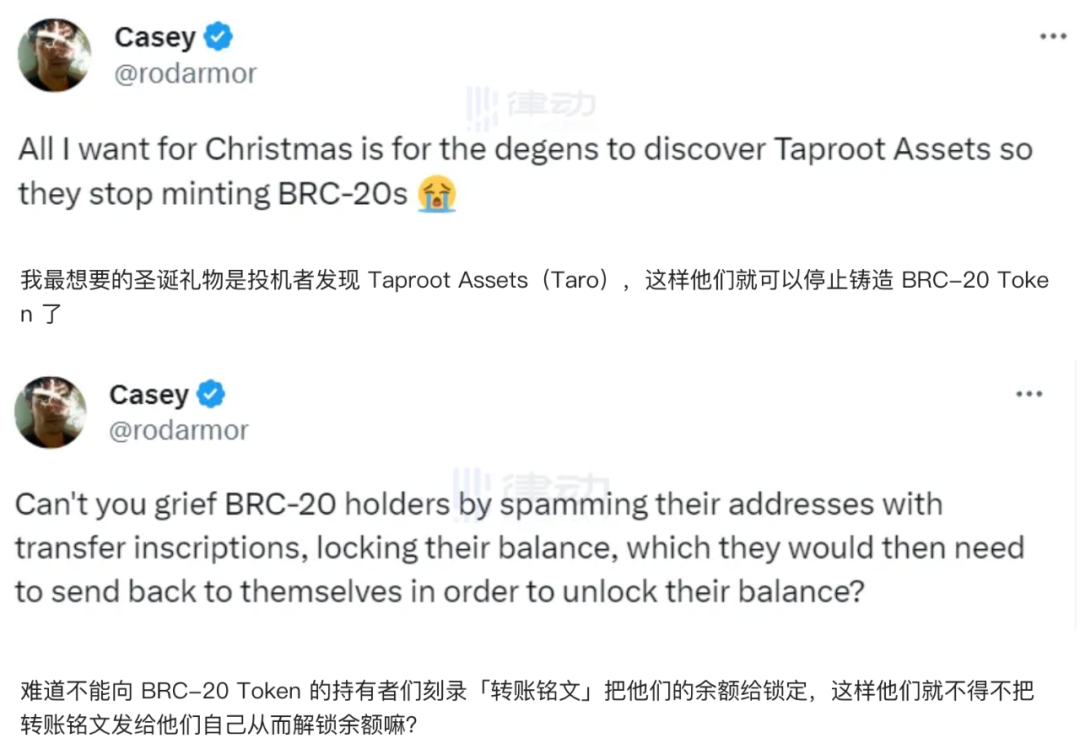
V. Official Birth of the RUNE Protocol
- On September 28, 2023, Casey wrote a blog proposing the RUNE token protocol based on the UTXO model.
- Casey Rodarmor summarized the biggest feature of the "Runes" protocol in one sentence: a simple, UTXO-based protocol that enables Bitcoin users to have a good user experience with fungible tokens (FT).
- Casey believes that if the protocol has a small on-chain "footprint" and promotes trusted UTXO management, it may reduce "harm" compared to existing Bitcoin FT protocols. The popularity of BRC-20 has already created a large amount of "junk" UTXO.
- Casey compared the "Runes" protocol with other existing Bitcoin FT protocols in four aspects: complexity, user experience, state model, and native token operations.
- The comparison results showed that BRC-20 is not UTXO-based and quite complex, RGB is complex and relies on off-chain data, Counterparty and Omni Layer require native tokens for certain operations, and Taproot Assets (Taro) is somewhat complex and relies on off-chain data.
- The balance of "Runes" tokens is directly contained within UTXOs, and UTXOs can contain any amount of "Runes" tokens.
- The transfer of "Runes" tokens involves decoding the first data output of the protocol message, which contains information about ID, OUTPUT, and AMOUNT. If the decoded integer sequence is not a multiple of 3, the protocol message is considered invalid.
- The creation of "Runes" tokens involves decoding the second data output of the transaction, which contains information about SYMBOL and DECIMALS. If there are additional integers, the creation will be invalid.
- The core idea behind Runes is to minimize its on-chain footprint and encourage responsible UTXO management, aiming to seamlessly integrate with Bitcoin's native UTXO model.
- Runes has the potential to promote responsible UTXO management and contribute to the overall health and efficiency of the Bitcoin blockchain.
- RuneAlpha is an early practical project based on the RUNE protocol, which has made significant contributions to the implementation of the protocol and introduced new use cases, developers, and users to the Lightning Network.
- RuneAlpha founder @sondotpin has attracted widespread attention in the market with the release of the $COOK token, which is currently valued at 27 million USD, and OKX has publicly announced support for RuneAlpha and integration of $COOK and other tokens into the OKX wallet.
At the same time, RuneAlpha announced its latest airdrop plan, where holders of $COOK can receive NFT airdrops. They also released the roadmap for 2024, which includes the development of Rune wallet, decentralized exchange, RWA, NFT, and other infrastructure and ecosystem related to Runes.
Seven, RUNECOIN Airdrops RISC Inscriptions, and Successfully Attracts Market Attention to Runes through RISC Mining
On January 20, 2024, the RUNECOIN project was established and announced the airdrop of RSIC inscriptions. After the mainnet launch, they will be exchanged for RUNE protocol according to the corresponding ratio.
The RSIC inscriptions airdropped by RUNECOIN were mainly distributed to long-term holders of inscriptions, attracting attention from prominent figures in the crypto community such as @0xcryptowizard, and successfully achieved widespread marketing of Runes. The tokens were locked through mining, opening up ideas for future Runes marketing.
Eight, Establishment of the Official Chinese Community for the RUNE Protocol
The Runes Chinese community Twitter account @RunesCC was established on January 4, 2024, initiated by Mix. Initially, it was only two authors @MixRestaking and @Rock_Lee_520 writing short articles on Twitter. Later, more core promoters and influencers joined, such as:
- @lilyanna_btc
- @yzr668
- @Alina19990420
- RuneAlpha founder @sondotpin
The participation of prominent figures on Twitter made the "Runes Chinese Core Power Group" the strongest consensus WeChat group for the current RUNES protocol. On the day of the group's establishment, the price of $COOK rose by over 45%. The Chinese community will continue to expand and select core members from the existing community as group administrators.
$COOK price data source: RuneAlpha Market
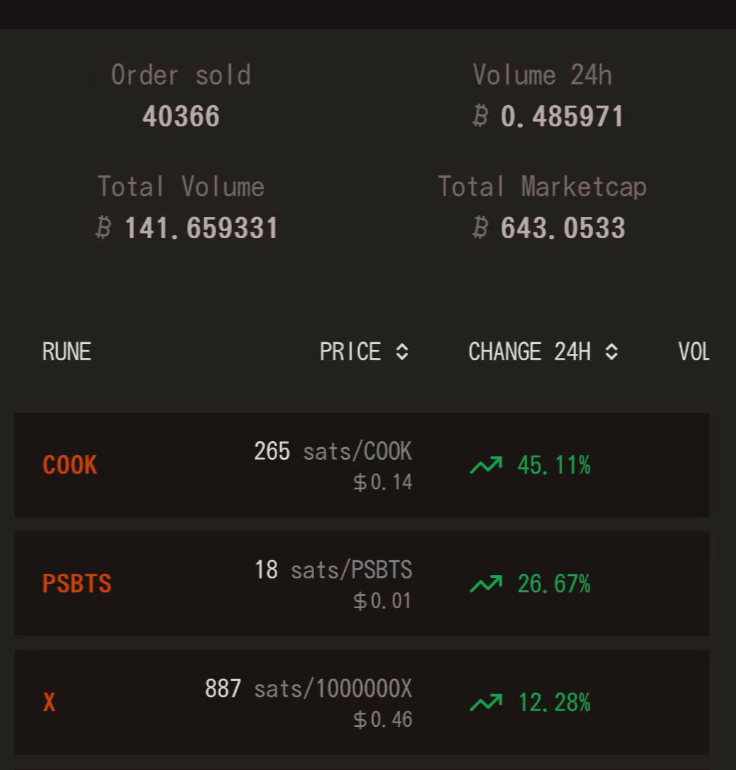
This article is compiled and summarized based on excellent articles found on the internet. Thanks to all the authors for their contributions to the Rune protocol:
免责声明:本文章仅代表作者个人观点,不代表本平台的立场和观点。本文章仅供信息分享,不构成对任何人的任何投资建议。用户与作者之间的任何争议,与本平台无关。如网页中刊载的文章或图片涉及侵权,请提供相关的权利证明和身份证明发送邮件到support@aicoin.com,本平台相关工作人员将会进行核查。




